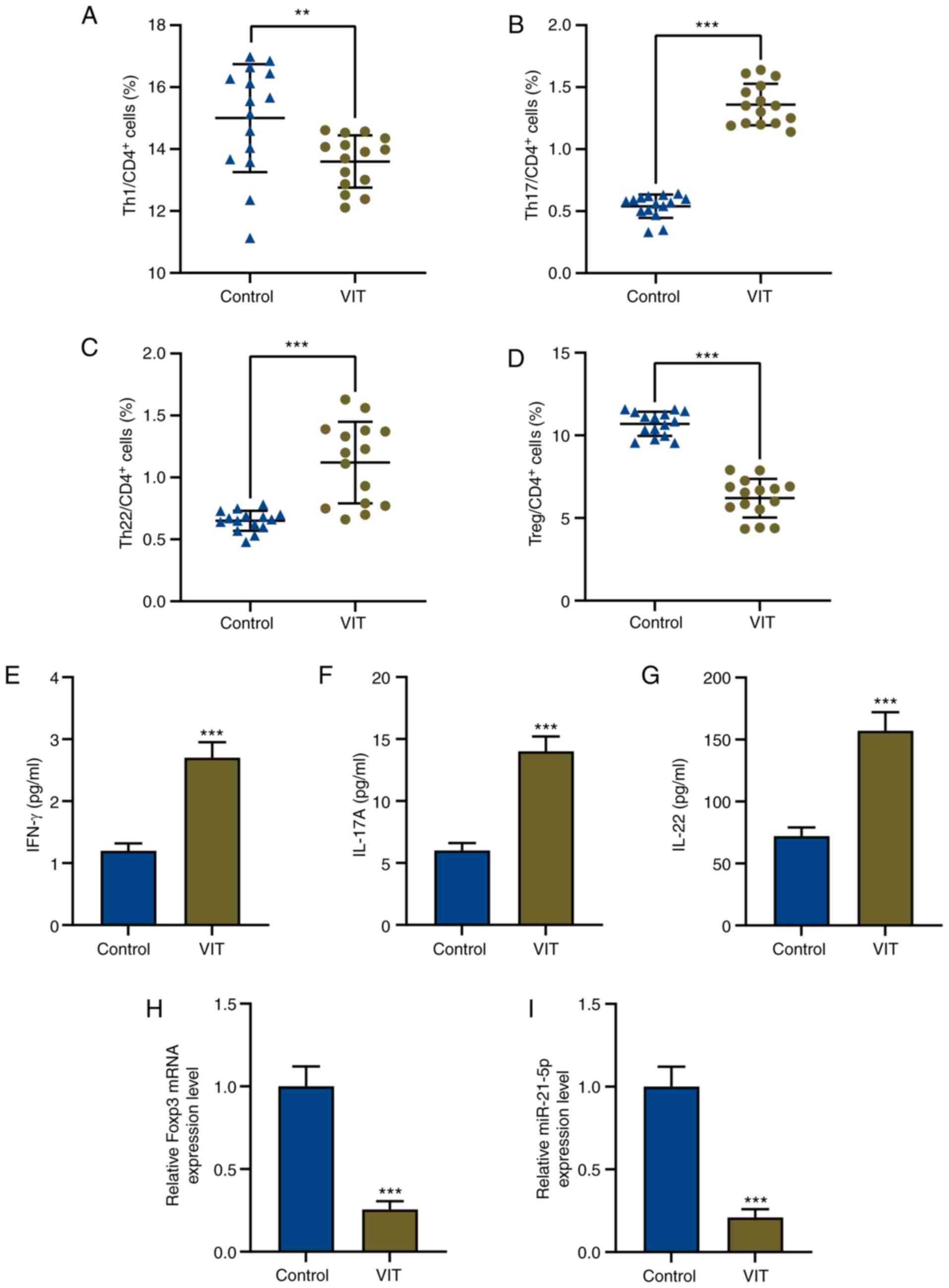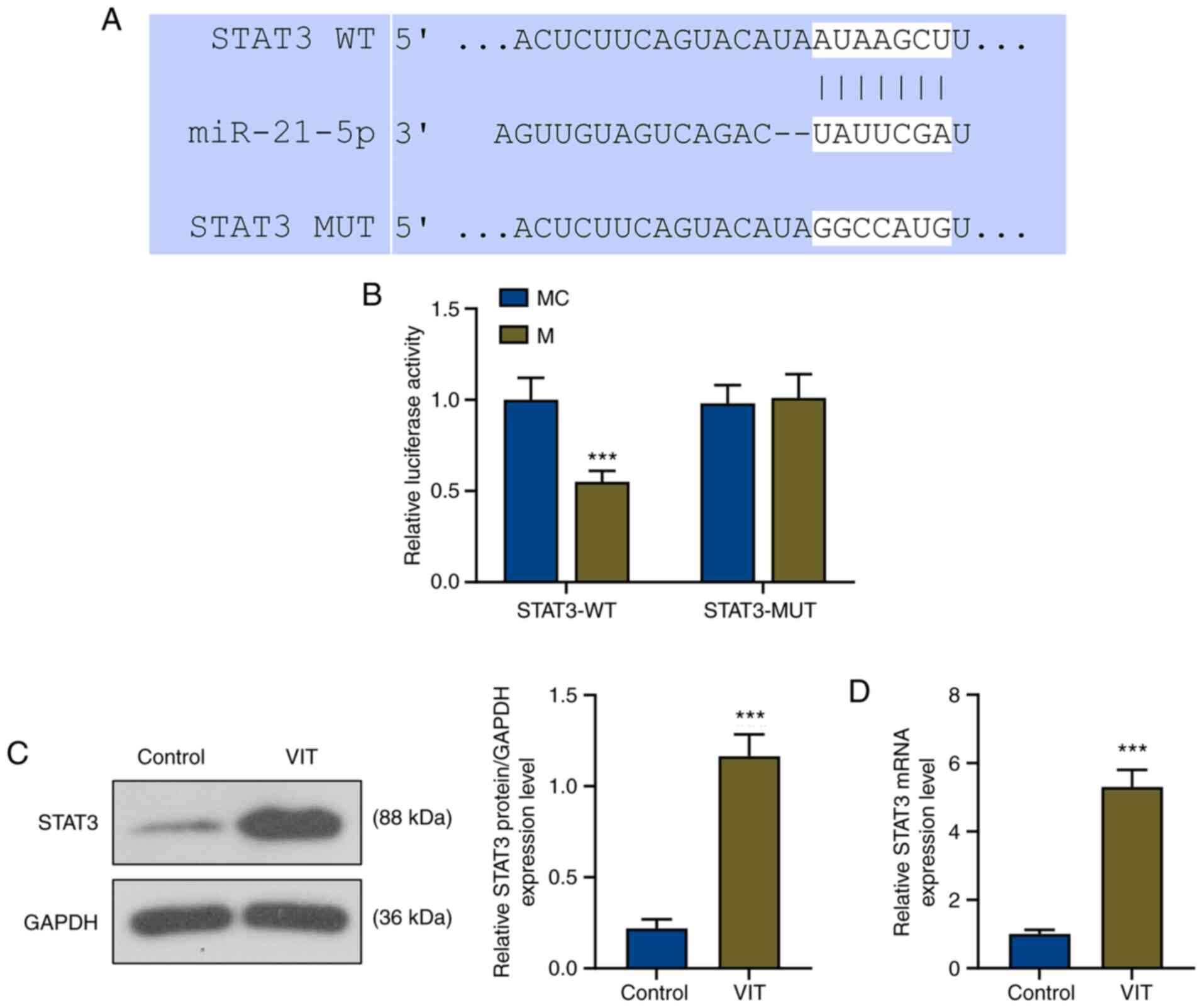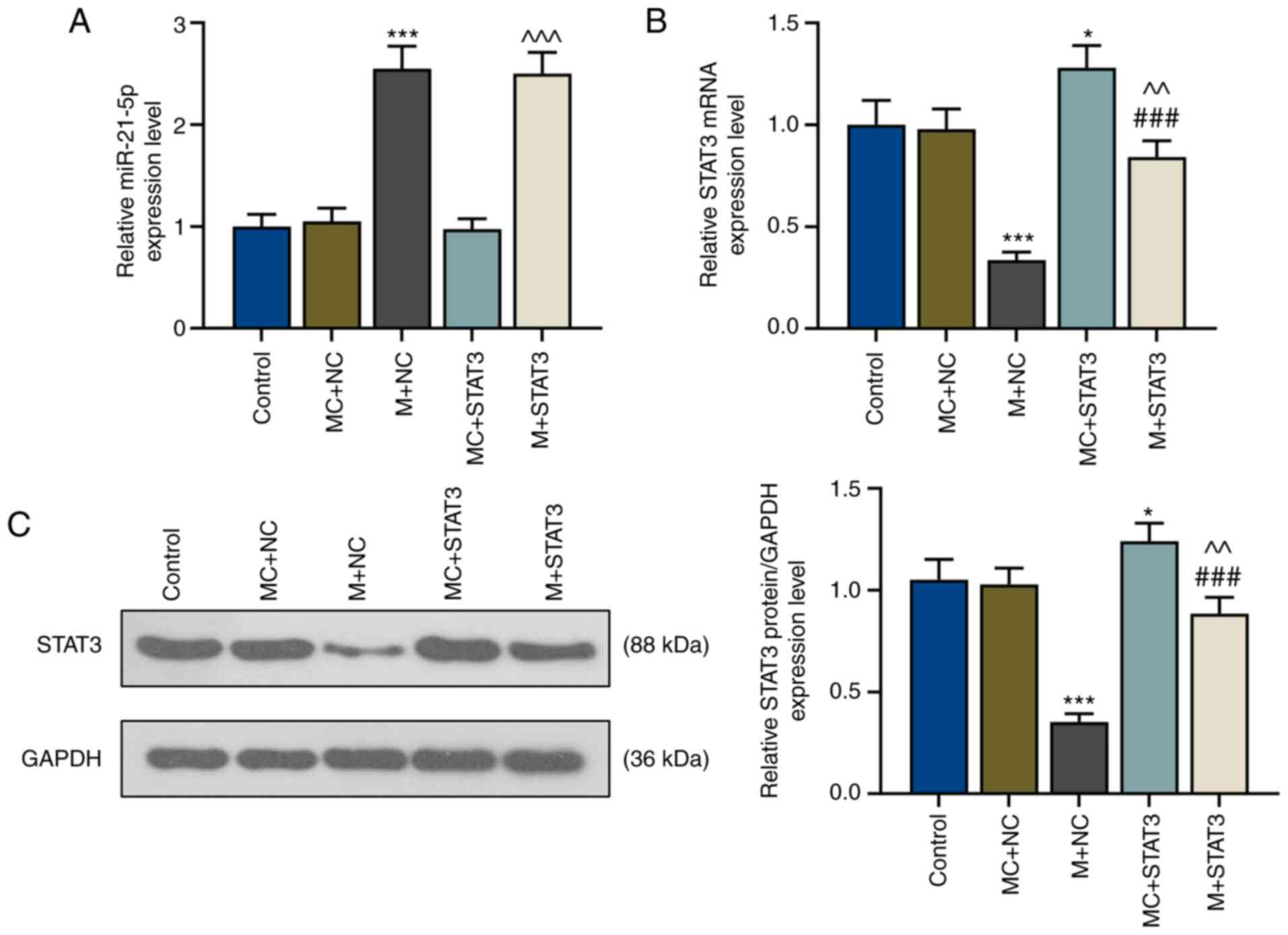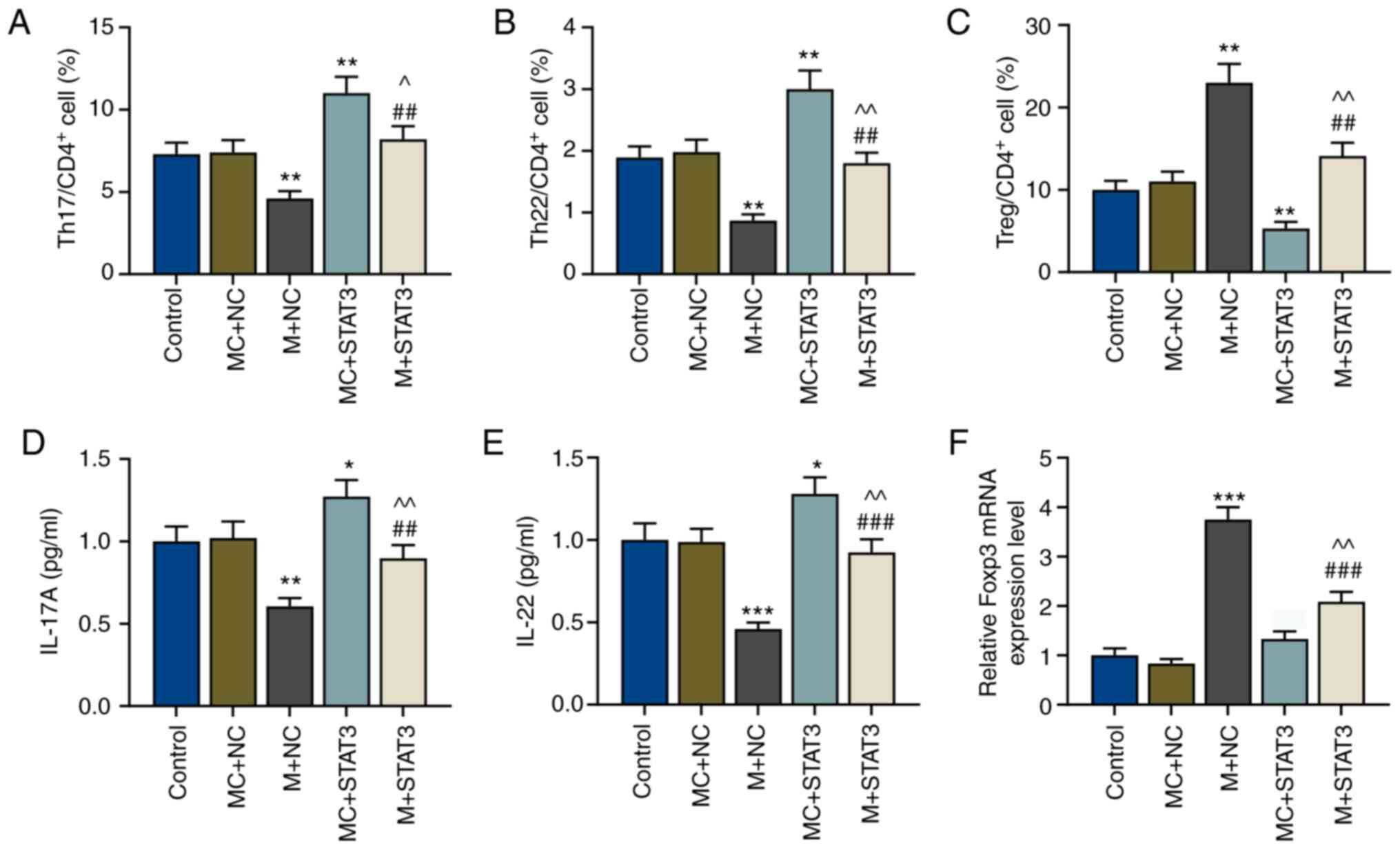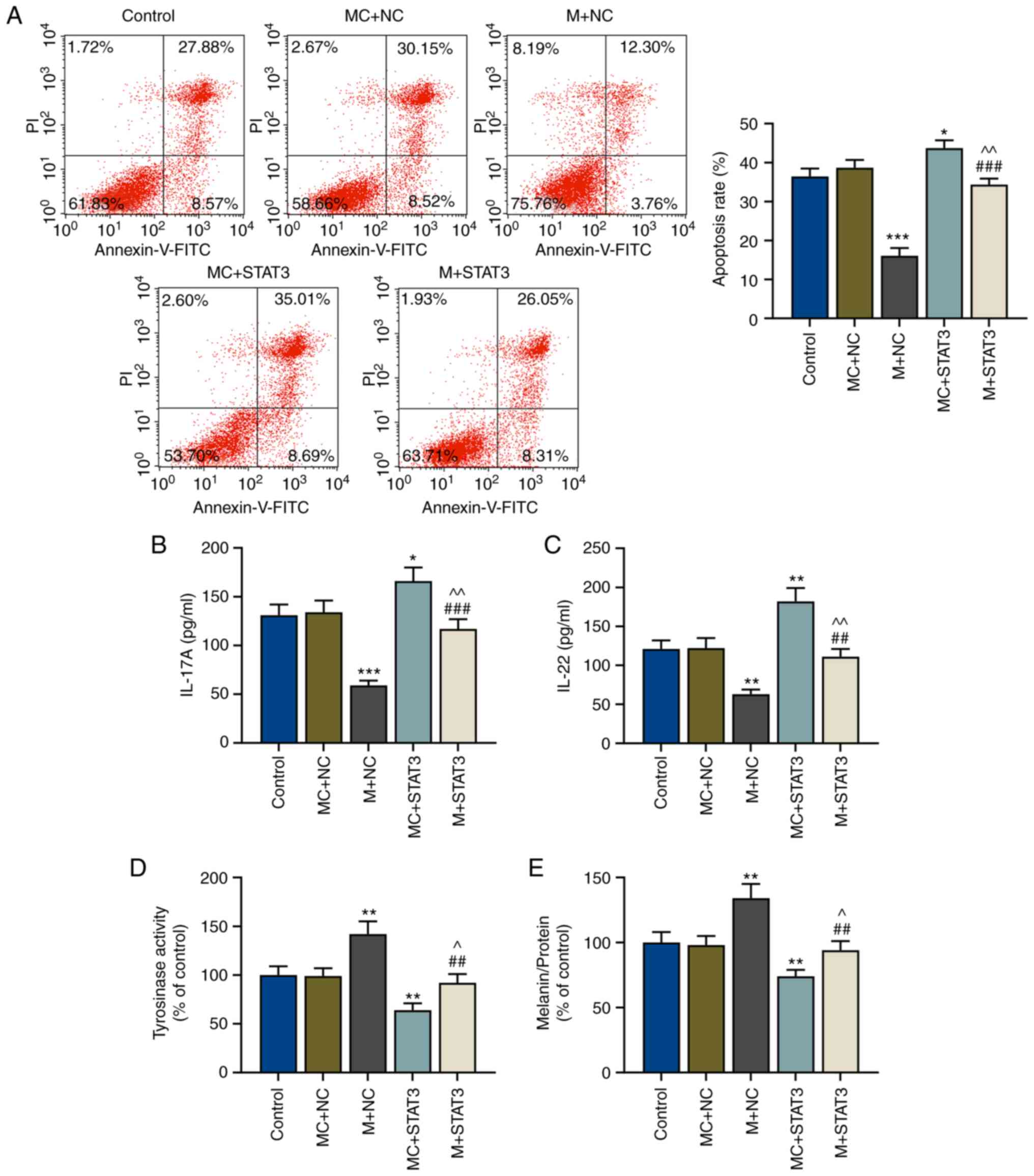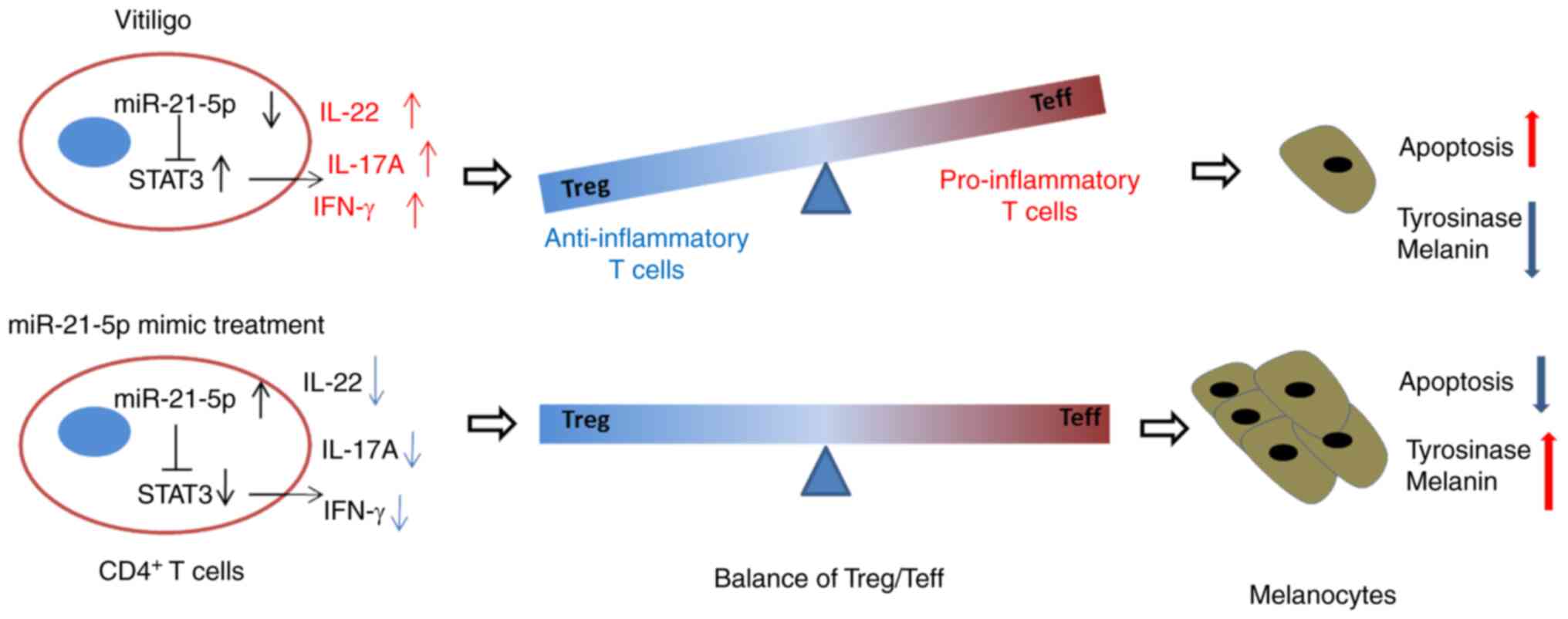|
1
|
Ezzedine K, Eleftheriadou V, Whitton M and
van Geel N: Vitiligo. Lancet. 386:74–84. 2015. View Article : Google Scholar : PubMed/NCBI
|
|
2
|
Lai YC, Yew YW, Kennedy C and Schwartz RA:
Vitiligo and depression: A systematic review and meta-analysis of
observational studies. Br J Dermatol. 177:708–718. 2017. View Article : Google Scholar : PubMed/NCBI
|
|
3
|
Xie H, Zhou F, Liu L, Zhu G, Li Q, Li C
and Gao T: Vitiligo: How do oxidative stress-induced autoantigens
trigger autoimmunity? J Dermatolo Sci. 81:3–9. 2016. View Article : Google Scholar
|
|
4
|
Lv M, Li Z, Liu J, Lin F, Zhang Q, Li Z,
Wang Y, Wang K and Xu Y: MicroRNA155 inhibits the proliferation of
CD8+ T cells via upregulating regulatory T cells in
vitiligo. Mol Med Rep. 20:3617–3624. 2019.PubMed/NCBI
|
|
5
|
Lin JY and Fisher DE: Melanocyte biology
and skin pigmentation. Nature. 445:843–850. 2007. View Article : Google Scholar : PubMed/NCBI
|
|
6
|
Patel S, Rauf A, Khan H, Meher BR and
Hassan SSU: A holistic review on the autoimmune disease vitiligo
with emphasis on the causal factors. Biomed Pharmacother.
92:501–508. 2017. View Article : Google Scholar : PubMed/NCBI
|
|
7
|
Frisoli ML and Harris JE: Vitiligo:
Mechanistic insights lead to novel treatments. J Allergy Clin
Immunol. 140:654–662. 2017. View Article : Google Scholar : PubMed/NCBI
|
|
8
|
Sabat R, Wolk K, Loyal L, Docke WD and
Ghoreschi K: T cell pathology in skin inflammation. Semin
Immunopathol. 41:359–377. 2019. View Article : Google Scholar : PubMed/NCBI
|
|
9
|
Zhu W, Chen X, Yu J, Xiao Y, Li Y, Wan S,
Su W and Liang D: Baicalin modulates the Treg/Teff balance to
alleviate uveitis by activating the aryl hydrocarbon receptor.
Biochem Pharmacol. 154:18–27. 2018. View Article : Google Scholar : PubMed/NCBI
|
|
10
|
Wang Y, Zhang S, Liang Z, Feng M, Zhao X,
Qin K, Gao C, Li X, Guo H and Luo J: Metformin attenuates
bleomycin-induced scleroderma by regulating the balance of
Treg/Teff cells and reducing spleen germinal center formation. Mol
Immunol. 114:72–80. 2019. View Article : Google Scholar : PubMed/NCBI
|
|
11
|
Kalekar LA and Rosenblum MD: Regulatory T
cells in inflammatory skin disease: From mice to humans. Int
Immunol. 31:457–463. 2019. View Article : Google Scholar : PubMed/NCBI
|
|
12
|
De Santis G, Ferracin M, Biondani A,
Caniatti L, Rosaria Tola M, Castellazzi M, Zagatti B, Battistini L,
Borsellino G, Fainardi E, et al: Altered miRNA expression in T
regulatory cells in course of multiple sclerosis. J Neuroimmunol.
226:165–171. 2010. View Article : Google Scholar : PubMed/NCBI
|
|
13
|
Mansuri MS, Singh M and Begum R: miRNA
signatures and transcriptional regulation of their target genes in
vitiligo. J Dermatol Sci. 84:50–58. 2016. View Article : Google Scholar : PubMed/NCBI
|
|
14
|
Yan S, Shi J, Sun D and Lyu L: Current
insight into the roles of microRNA in vitiligo. Mol Biol Rep.
47:3211–3219. 2020. View Article : Google Scholar : PubMed/NCBI
|
|
15
|
Zheng X, Dong L, Wang K, Zou H, Zhao S,
Wang Y and Wang G: MiR-21 participates in the PD-1/PD-L1
pathway-mediated imbalance of Th17/Treg cells in patients after
gastric cancer resection. Ann Surg Oncol. 26:884–893. 2019.
View Article : Google Scholar : PubMed/NCBI
|
|
16
|
Dong L, Wang X, Tan J, Li H, Qian W, Chen
J, Chen Q, Wang J, Xu W, Tao C and Wang S: Decreased expression of
microRNA-21 correlates with the imbalance of Th17 and Treg cells in
patients with rheumatoid arthritis. J Cell Mol Med. 18:2213–2224.
2014. View Article : Google Scholar : PubMed/NCBI
|
|
17
|
Rouas R, Fayyad-Kazan H, El Zein N,
Lewalle P, Rothé F, Simion A, Akl H, Mourtada M, El Rifai M, Burny
A, et al: Human natural Treg microRNA signature: Role of
microRNA-31 and microRNA-21 in FOXP3 expression. Eur J Immunol.
39:1608–1618. 2009. View Article : Google Scholar : PubMed/NCBI
|
|
18
|
Tscherner A, Brown AC, Stalker L, Kao J,
Dufort I, Sirard MA and LaMarre J: STAT3 signaling stimulates
miR-21 expression in bovine cumulus cells during in vitro oocyte
maturation. Sci Rep. 8:115272018. View Article : Google Scholar : PubMed/NCBI
|
|
19
|
Fuss IJ, Kanof ME, Smith PD and Zola H:
Isolation of whole mononuclear cells from peripheral blood and cord
blood. Curr Protoc Immunol Chapter. 7:Unit7.1. 2009.
|
|
20
|
Livak KJ and Schmittgen TD: Analysis of
relative gene expression data using real-time quantitative PCR and
the 2(-Delta Delta C(T)) method. Methods. 25:402–408. 2001.
View Article : Google Scholar : PubMed/NCBI
|
|
21
|
Banerjee K, Pru C, Pru JK and Resat H:
STAT3 knockdown induces tumor formation by MDA-MB-231 cells. Clin
Oncol Res. 1:10.31487/j.COR.2018.10.002. 2018.PubMed/NCBI
|
|
22
|
Huang Z, Yang B, Shi Y, Cai B, Li Y, Feng
W, Fu Y, Luo L and Wang L: Anti-TNF-α therapy improves Treg and
suppresses Teff in patients with rheumatoid arthritis. Cell
Immunol. 279:25–29. 2012. View Article : Google Scholar : PubMed/NCBI
|
|
23
|
Yang WY, Shao Y, Lopez-Pastrana J, Mai J,
Wang H and Yang XF: Pathological conditions re-shape physiological
tregs into pathological tregs. Burns Trauma. 3:12015. View Article : Google Scholar : PubMed/NCBI
|
|
24
|
Saini C, Siddiqui A, Ramesh V and Nath I:
Leprosy reactions show increased Th17 cell activity and reduced
FOXP3+ Tregs with concomitant decrease in TGF-β and
increase in IL-6. PLoS Negl Trop Dis. 10:e00045922016. View Article : Google Scholar : PubMed/NCBI
|
|
25
|
Liu C, Yang H, Shi W, Wang T and Ruan Q:
MicroRNA-mediated regulation of T helper type 17/regulatory T-cell
balance in autoimmune disease. Immunology. 155:427–434. 2018.
View Article : Google Scholar : PubMed/NCBI
|
|
26
|
Catalanotto C, Cogoni C and Zardo G:
MicroRNA in control of gene expression: An overview of nuclear
functions. Int J Mol Sci. 17:17122016. View Article : Google Scholar
|
|
27
|
van der Fits L, van Kester MS, Qin Y,
Out-Luiting JJ, Smit F, Zoutman WH, Willemze R, Tensen CP and
Vermeer MH: MicroRNA-21 expression in CD4+ T cells is
regulated by STAT3 and is pathologically involved in Sezary
syndrome. J Invest Dermatol. 131:762–768. 2011. View Article : Google Scholar : PubMed/NCBI
|
|
28
|
Iliopoulos D, Jaeger SA, Hirsch HA, Bulyk
ML and Struhl K: STAT3 activation of miR-21 and miR-181b-1 via PTEN
and CYLD are part of the epigenetic switch linking inflammation to
cancer. Mol Cell. 39:493–506. 2010. View Article : Google Scholar : PubMed/NCBI
|
|
29
|
Almasi-Nasrabadi M, Amoli MM, Robati RM,
Rajabi F, Ghalamkarpour F and Gauthier Y: CDH1 and DDR1 common
variants confer risk to vitiligo and autoimmune comorbidities.
Gene. 700:17–22. 2019. View Article : Google Scholar : PubMed/NCBI
|
|
30
|
Samaka RM, Basha MA and Menesy D: Role of
Janus kinase 1 and signal transducer and activator of transcription
3 in vitiligo. Clin Cosmet Investig Dermatol. 12:469–480. 2019.
View Article : Google Scholar : PubMed/NCBI
|
|
31
|
Rashighi M and Harris JE: Vitiligo
pathogenesis and emerging treatments. Dermatol Clin. 35:257–265.
2017. View Article : Google Scholar : PubMed/NCBI
|
|
32
|
Zhou J, Ling J, Song J, Wang Y, Feng B and
Ping F: Interleukin 10 protects primary melanocyte by activation of
Stat-3 and PI3K/Akt/NF-κB signaling pathways. Cytokine. 83:275–281.
2016. View Article : Google Scholar : PubMed/NCBI
|















